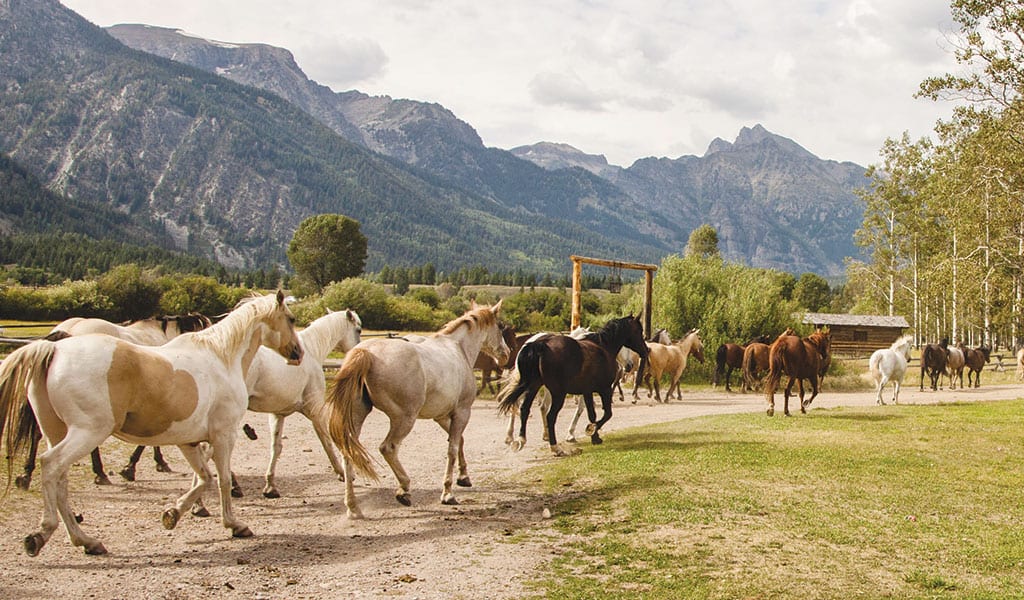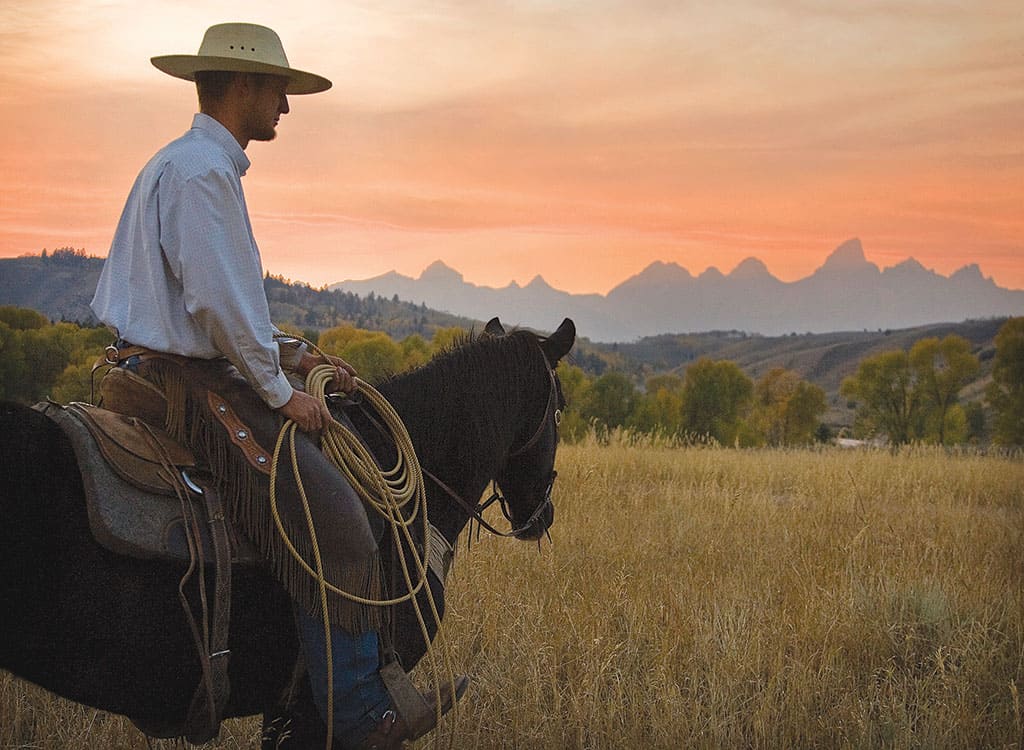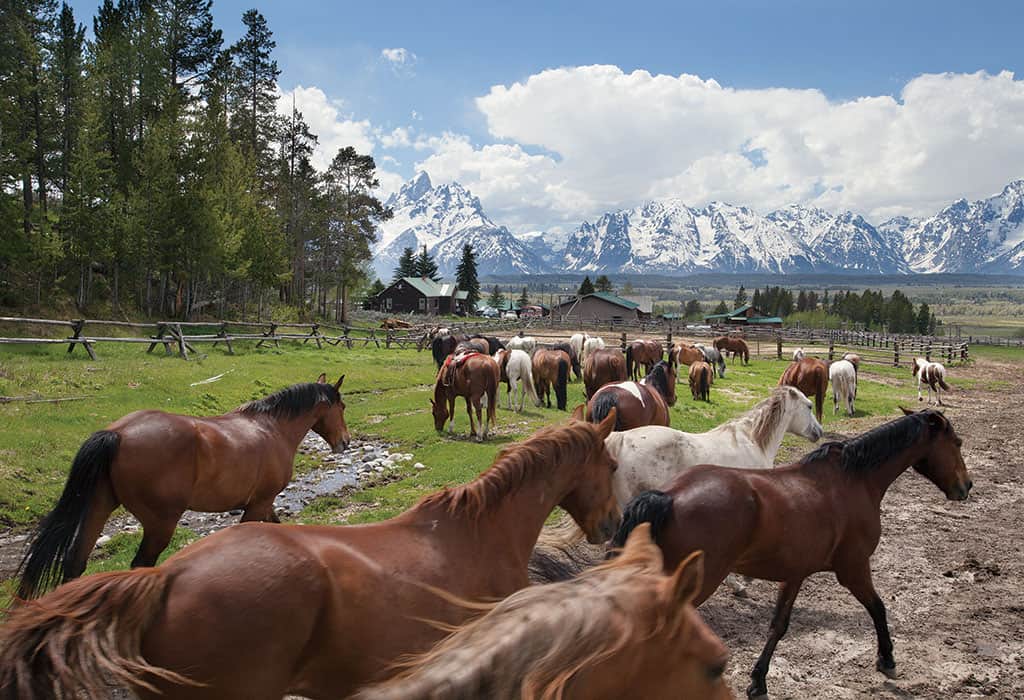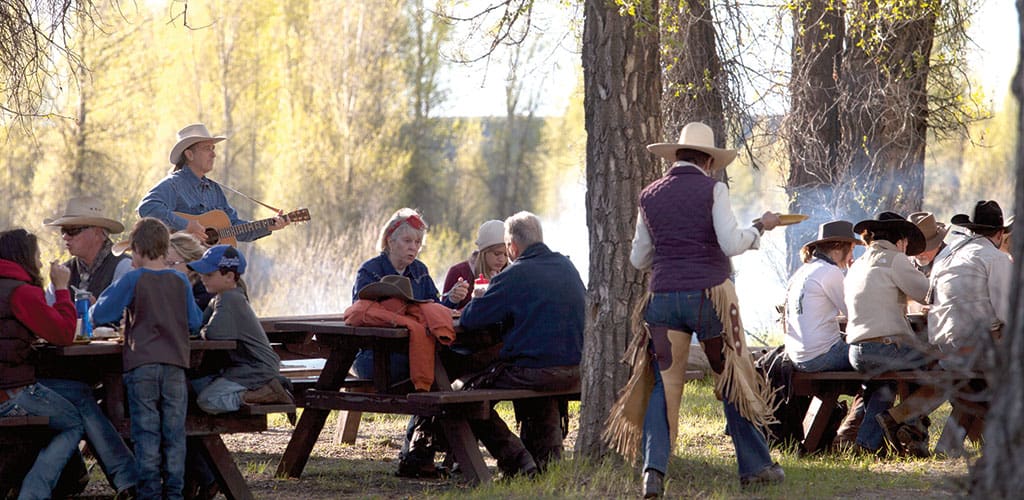Read The
Current Issue
Dude, It’s a Hard Business
Dude ranching has been a mainstay of the valley’s economy since the 1920s, but it has never been easy.
By Brigid Mander

WHEN LORING WOODMAN decided to sell the historic Darwin Ranch, one of the most remote guest ranches in the area, located deep in the Gros Ventre Mountains between Jackson and Bondurant, it wasn’t an easy task to find the right buyer for the land, barns, and cabins. Woodman put the isolated 160-acre inholding in the Bridger-Teton National Forest abutting the Gros Ventre Wilderness—with no cell service—on the market for $8.5 million, and hoped for the best.
When Woodman bought the Darwin in 1964, it was merely a pioneers’ outpost. He restored the main house and five historic cabins, which had fallen into disrepair, into comfortable but spare guest lodging, as well as a few outbuildings, and ran it as a summer guest ranch for the next fifty years. The ranch sold in 2014 to San Francisco-based Paul Klingenstein and Kathy Bole, who operate it much the same as Woodman did, down to retaining the staff that have worked there for decades.
The Darwin met with a very lucky outcome. Today it is most often developers buying dude ranches. Raising cattle isn’t as profitable as it once was, and ranching in any capacity is hard physical labor. On top of that, in areas like Jackson where real estate prices are sky-high, the temptation to sell for top dollar to developers, as opposed to more conservation-minded buyers, can be tough to resist.
Already the owners of a working agricultural ranch (run by a ranch manager) in Cody, Wyoming, Bole and Klingenstein have a strong interest in sustainable farming, conservation, and environmental issues. And they had the ability to purchase and operate the Darwin. “We view the ranch as part of a wild ecosystem, and try to enhance this relationship by building wildlife-friendly fences, controlling grazing to maintain healthy pastures, generating our power from the creek, and in general trying to minimize our footprint,” Bole says. “We have been implementing these practices at the ranch in Cody, and supply the Darwin kitchen with our grass-fed beef and lamb, pastured pork, and garden produce; we supplement with produce from Teton and Sublette County farmers whenever possible, and make an effort to buy from local producers. We are careful of our impact on the land, both physical and visual, to preserve this sense of wildness.”

Although they didn’t have to keep the ranch open to the public, Bole and Klingenstein realized the unique and valuable opportunity to experience the wilderness that the Darwin provides. “We were first drawn to the remarkable beauty of the place, and its remoteness, and then to the idea of preserving and stewarding the property. Loring had devoted so many years to building the business that it felt wrong to us to buy it and not at least try to keep it going as a guest ranch,” Bole says. “The [Darwin] has its roots in the Old West, as a hunting camp and a homestead, and that way of life carries over almost by necessity [because of the remoteness and difficulty of access]. But we are not particularly nostalgic for a past way of life, and don’t try to re-create that experience for our guests.” The Darwin has one landline—there is no cell service until about twenty or so miles down the road—and limited Internet service in the main house. Its draw remains the outdoors, where guests spend their days on horseback, fishing, or traipsing in the mountains. At night, dinners are served at big, communal tables, and evening entertainment usually consists of whiskey and conversation around the main-house fireplace.
THE HEYDAY OF Jackson Hole dude ranches was the 1920s. Easterners wanted to see the natural wonders of the West and live, at least for a month or two, the adventurous life of a cowboy. Ranchers, many of them on land they or their parents homesteaded, were happy to oblige, for a fee. They added cabins and began to advertise, and the dude ranch was born.
Dude ranches “are a uniquely western, uniquely American phenomenon,” says Katherine Wonson, director of the Western Center for Historic Preservation at the National Park Service. “People would leave their busy lives and jobs back East, come out, and pay to pretend to be ranchers for a month or two. And that was what travel to Jackson Hole was, historically.”
Today there are approximately 350 dude ranches in the western U.S. and Canada. About forty of these are in Wyoming, according to Colleen Hodson, executive director of the Dude Ranchers’ Association. There are about a dozen guest ranches in and around Jackson today—from the Darwin to the rustic-but-modern Goosewing Ranch; the luxurious Lost Creek; the horse-heavy Gros Ventre River Ranch; and Flat Creek Ranch, which is even more popular with anglers than aspiring cowboys for its location on a lake beneath Sleeping Indian.
It is a tough business, though, and those who are in it do it for love of the culture. “It’s not for the faint of heart,” Hodson says. Kelly and Nancy Stirn own and operate the R Lazy S Ranch on the Snake River near Teton Village. Kelly Stirn admits it’s a tough job. “We don’t run cattle anymore. It’s enough work with our herd of about seventy horses and forty guests [maximum] a week for sixteen weeks during the summer,” he says. The business is healthy, and makes enough money to operate and cover repairs and upkeep, but that’s about it, Stirn says.
Additionally, any ranch that operates with a grazing permit on public land has to deal with the U.S. Forest Service and Bureau of Land Management on renewals and other land-use issues. Traditionally, ranch permits were for one hundred years, but those are becoming few and far between, sending ranches into fights for survival with government agencies, Hodson says.

The Triangle X Ranch in Grand Teton National Park has been in continuous operation for ninety years, ever since it opened in the fall of 1926. Unique in its location inside a national park, the ranch and its history made national news in 2011 when the Turner family, now in their fifth generation on the ranch, brought a federal lawsuit against the National Park Service. Since the founding of GTNP, Triangle X has been allowed to operate as a concession (private business) within the park. But a 1998 federal law stated that every ten years the Turners had to compete against other concessionaires to continue to run their ranch. If another party won the bid, the Turners would lose the right to their ranch. The family alleged it had the right to continue to operate under its original agreement from the early twentieth century. Although some complicated historic and economic factors remain, the family won its bid to keep the Triangle X for the time being.
WHILE THE TRIANGLE X remains fairly traditional—although not nearly as isolated as the Darwin—other valley dude ranches have evolved with the times and changing preferences of some types of guests. “Guests today don’t always just want the traditional dude ranch experience of years ago. They expect a little more in terms of recreation options,” says Amy Worster, general manager of the Goosewing Ranch, a remote former homestead in the Gros Ventre River Valley north of Jackson that has been a dude ranch since the 1960s.
The Goosewing is no longer a working cattle ranch. “Our business model now is a resort ranch,” Worster says. “Our guests still want to escape daily life and reconnect with family, but now we give them the opportunity for a lot of micro-adventures in addition to horseback riding. We’ve gone from a very rustic property to something that can compete with high-end, big resorts. But we still have a maximum of thirty-five guests at a time.”
Despite the Goosewing’s isolation and lack of cell service, business is booming. Worster reports that as of December 2015, the ranch was already taking reservations for the 2017 summer season. “The industry seems to be getting stronger year over year,” she says.

NOT ALL guests look for a resort-y ranch. The Triangle X, and also the R Lazy S, continues to offer a traditional dude ranch experience. Stirn believes that the ranches are a special place for a certain kind of person. “Dude ranches used to require a letter of recommendation,” he says. “People used to come for weeks on end and stay together on the ranch, so if you got the wrong kind of person in there, things could be miserable.”
The Darwin’s Bole says: “If [guests] bring their present-day thinking to the experience, there’s a chance that the engagement will become a lasting one. We continue to value hard work, thrift, and living simply off the land. We have a chance to introduce people to truly wild places, and we would rather they engage with the mountains in a way that doesn’t ask them to be something other than themselves.”
The R Lazy S adhered to the letters-of-recommendation policy for years. The practice only fell off over the last decade. Stirn says today a phone conversation with potential new guests is sufficient for both parties to decide if the ranch is the right vacation. For the families it is right for, the R Lazy S is really right. Many guests come back year after year, bringing kids and grandkids, passing the tradition through generations and, hopefully, keeping the businesses going. JH




